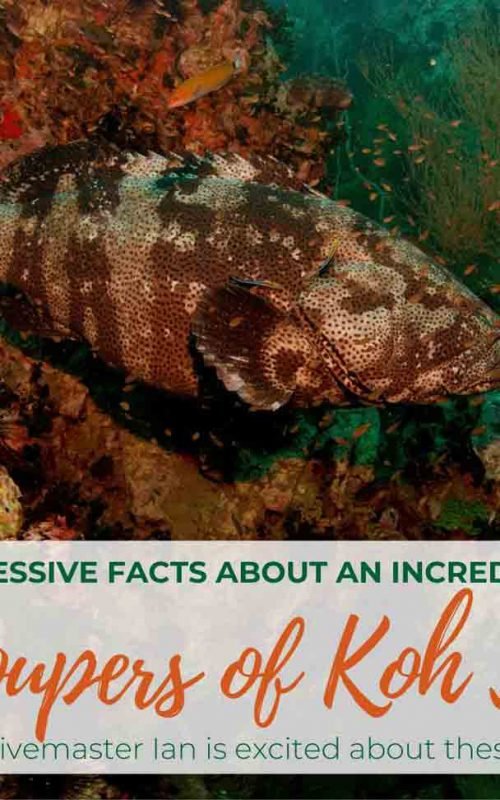Our Divemasters are true experts at finding all the cool stuff out there: They know where smallest crustaceans hide and can usually find at least three different types of nudibranches any given dive. We asked Divemaster Ian about some of his favourite marine animals and what stuff he enjoys looking at during his dives. His answer might actually surprise you…
Why you should look for groupers on every single dive
When asked what they would like to see while diving on Koh Tao (or in general) most divers will say: “Whale Shark!”, “Turtle!”, or even “Shark!” Of course, these are all beautiful and amazing marine creatures to have an underwater encounter with, but I personally think that there is another giant out there that’s more often than not a big surprise for many divers: the Grouper!

Ian is in his element – on the lookout for more groupers…
Did you know that…
- Species – we have several common species of groupers in Koh Tao including Peacock, Blacktip, Honeycomb, Roving coral, Brown marbled and Blue lined. They range in size from a few inches to several feet and come in a variety of colours and patterns.
- Size – the largest known species in the world is the Giant grouper reaching a massive 270cm (over 8 feet).
- Behaviours – groupers are roaming predators who use ambush tactics to secure food. They patrol territories close to the reef bottom and either sit in waiting for passing prey or slowly sneak closer before a blinding fast attack.
- Gender studies – nearly all groupers are protogynous hermaphrodites; that is, they all begin as females and after reaching maturity can transform into males.
- Mating procedures – this is beneficial to the species because if a female finds they are bigger than most males they have a better chance of reproducing as a male. While smaller females know it’s best to remain female as they have better chances to reproduce with bigger males. Either way, everyone wins.
Where can you find groupers on Koh Tao?
The grouper can often be found in areas of rock, coral, and mud bottoms. They are rather solitary and remain territorial near their ‘favourite’ areas such as caves, wrecks, or ledges. You can often see them with an open mouth and quivering body to intruders.

Image credit: Rob Kelly, Ocean Secrets
Around Koh Tao the larger groupers are found most often around the deeper dives sites, Chumphon Pinnacle, South West and of course Sail Rock. These impressive apex predators (yes, that’s right, apex predators! Top of the food chain, baby) can also be found at much shallower sites in spots you wouldn’t expect to see them. I’ve seen one hiding in one of the swim throughs at Green Rock, under cover of the concrete blocks in Tanote Bay and chilling out in the open along the wall at Mango Bay.
Video credit: WTC Productions
The largest recorded grouper was measured as being 2.70m (8.8ft) long, but I am truly convinced that there’s one out at Chumphon Pinnacle that is longer than I am tall – which is a good 1.90m (6.2ft), but he’s never let me close enough to truly test the theory. These monsters can weigh in at up to 400kg making them the largest coral dwelling bony fish in the ocean.
Chill Factor: 100
The opportunistic grouper feeds on a variety of marine life all the way from spiny lobsters right up to some of the smaller sharks. That’s right, sharks! Having eyes that can rotate and see remarkably well in the dark allows the giant grouper to remain stationary while waiting for the unwary snack to swim past. Of course it helps to have a dark and light brown patched coloration and they perfectly blend in with their environment. Sometimes you could be hovering right on top of one without even realizing it’s there…

Image credit: Dan Lee
Our gentle giants, often appear to be lazy and uber-relaxed in the water; in fact they seem to spend more time resting on rocks or hanging around under shelter than anything else… But appearances can be deceptive: groupers swim slowly, but with power! They’re actually not capable of fast breaks or swimming long distances, but when they do hunt they can be surprisingly active and quick! Having witnessed one first hand snap up an unwitting barracuda at Chumphon Pinnacle, I certainly wouldn’t want get caught between a hungry grouper and its dinner!
While they make lack the gigantic grace of the whale shark, the chilled laziness of the turtle or the exhilaration of a shark encounter, these true giants can turn any dive into one that suddenly became even more exciting, interesting and awe inspiring.
